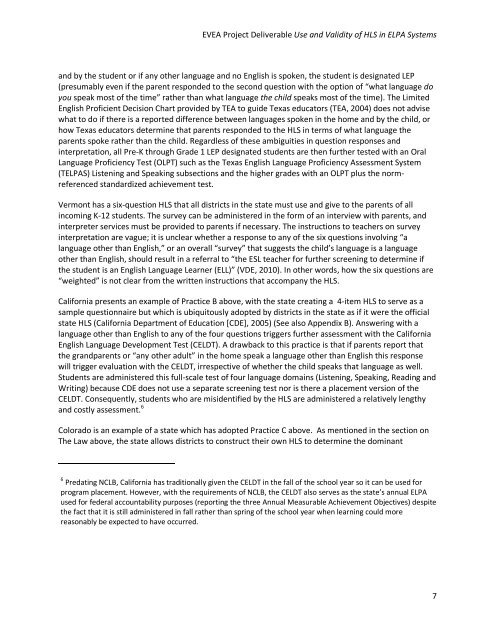The Use and Validity of Home Language Surveys in State English ...
The Use and Validity of Home Language Surveys in State English ...
The Use and Validity of Home Language Surveys in State English ...
You also want an ePaper? Increase the reach of your titles
YUMPU automatically turns print PDFs into web optimized ePapers that Google loves.
EVEA Project Deliverable <strong>Use</strong> <strong>and</strong> <strong>Validity</strong> <strong>of</strong> HLS <strong>in</strong> ELPA Systems<strong>and</strong> by the student or if any other language <strong>and</strong> no <strong>English</strong> is spoken, the student is designated LEP(presumably even if the parent responded to the second question with the option <strong>of</strong> “what language doyou speak most <strong>of</strong> the time” rather than what language the child speaks most <strong>of</strong> the time). <strong>The</strong> Limited<strong>English</strong> Pr<strong>of</strong>icient Decision Chart provided by TEA to guide Texas educators (TEA, 2004) does not advisewhat to do if there is a reported difference between languages spoken <strong>in</strong> the home <strong>and</strong> by the child, orhow Texas educators determ<strong>in</strong>e that parents responded to the HLS <strong>in</strong> terms <strong>of</strong> what language theparents spoke rather than the child. Regardless <strong>of</strong> these ambiguities <strong>in</strong> question responses <strong>and</strong><strong>in</strong>terpretation, all Pre-K through Grade 1 LEP designated students are then further tested with an Oral<strong>Language</strong> Pr<strong>of</strong>iciency Test (OLPT) such as the Texas <strong>English</strong> <strong>Language</strong> Pr<strong>of</strong>iciency Assessment System(TELPAS) Listen<strong>in</strong>g <strong>and</strong> Speak<strong>in</strong>g subsections <strong>and</strong> the higher grades with an OLPT plus the normreferencedst<strong>and</strong>ardized achievement test.Vermont has a six-question HLS that all districts <strong>in</strong> the state must use <strong>and</strong> give to the parents <strong>of</strong> all<strong>in</strong>com<strong>in</strong>g K-12 students. <strong>The</strong> survey can be adm<strong>in</strong>istered <strong>in</strong> the form <strong>of</strong> an <strong>in</strong>terview with parents, <strong>and</strong><strong>in</strong>terpreter services must be provided to parents if necessary. <strong>The</strong> <strong>in</strong>structions to teachers on survey<strong>in</strong>terpretation are vague; it is unclear whether a response to any <strong>of</strong> the six questions <strong>in</strong>volv<strong>in</strong>g “alanguage other than <strong>English</strong>,” or an overall “survey” that suggests the child’s language is a languageother than <strong>English</strong>, should result <strong>in</strong> a referral to “the ESL teacher for further screen<strong>in</strong>g to determ<strong>in</strong>e ifthe student is an <strong>English</strong> <strong>Language</strong> Learner (ELL)” (VDE, 2010). In other words, how the six questions are“weighted” is not clear from the written <strong>in</strong>structions that accompany the HLS.California presents an example <strong>of</strong> Practice B above, with the state creat<strong>in</strong>g a 4-item HLS to serve as asample questionnaire but which is ubiquitously adopted by districts <strong>in</strong> the state as if it were the <strong>of</strong>ficialstate HLS (California Department <strong>of</strong> Education [CDE], 2005) (See also Appendix B). Answer<strong>in</strong>g with alanguage other than <strong>English</strong> to any <strong>of</strong> the four questions triggers further assessment with the California<strong>English</strong> <strong>Language</strong> Development Test (CELDT). A drawback to this practice is that if parents report thatthe gr<strong>and</strong>parents or “any other adult” <strong>in</strong> the home speak a language other than <strong>English</strong> this responsewill trigger evaluation with the CELDT, irrespective <strong>of</strong> whether the child speaks that language as well.Students are adm<strong>in</strong>istered this full-scale test <strong>of</strong> four language doma<strong>in</strong>s (Listen<strong>in</strong>g, Speak<strong>in</strong>g, Read<strong>in</strong>g <strong>and</strong>Writ<strong>in</strong>g) because CDE does not use a separate screen<strong>in</strong>g test nor is there a placement version <strong>of</strong> theCELDT. Consequently, students who are misidentified by the HLS are adm<strong>in</strong>istered a relatively lengthy<strong>and</strong> costly assessment. 6Colorado is an example <strong>of</strong> a state which has adopted Practice C above. As mentioned <strong>in</strong> the section on<strong>The</strong> Law above, the state allows districts to construct their own HLS to determ<strong>in</strong>e the dom<strong>in</strong>ant6 Predat<strong>in</strong>g NCLB, California has traditionally given the CELDT <strong>in</strong> the fall <strong>of</strong> the school year so it can be used forprogram placement. However, with the requirements <strong>of</strong> NCLB, the CELDT also serves as the state’s annual ELPAused for federal accountability purposes (report<strong>in</strong>g the three Annual Measurable Achievement Objectives) despitethe fact that it is still adm<strong>in</strong>istered <strong>in</strong> fall rather than spr<strong>in</strong>g <strong>of</strong> the school year when learn<strong>in</strong>g could morereasonably be expected to have occurred.7


